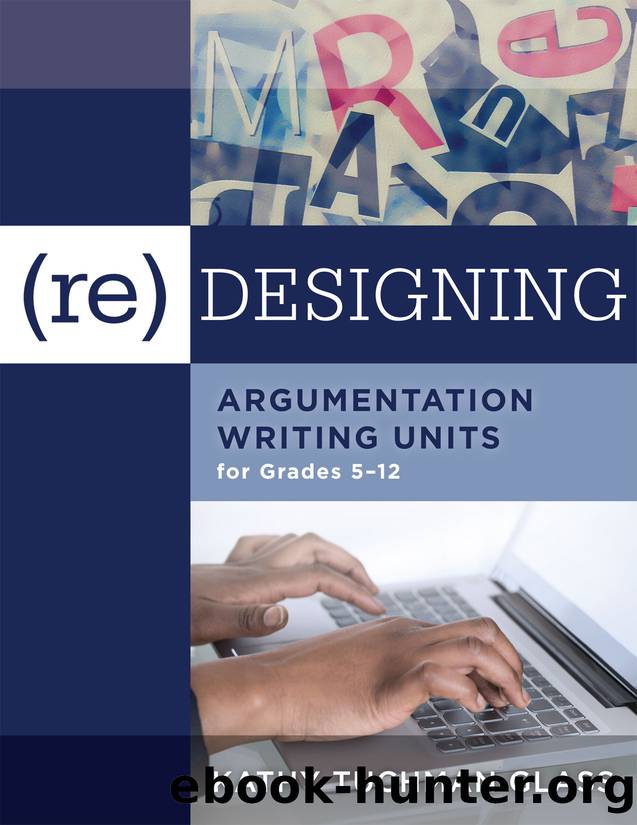(Re)designing Argumentation Writing Units for Grades 5-12 by Glass Kathy Tuchman;

Author:Glass, Kathy Tuchman;
Language: eng
Format: epub
Publisher: Solution Tree
Published: 2017-08-15T00:00:00+00:00
KUDs and Guiding Questions
To orient you to this topic and where it resides within the entire unit, here are the KUDs and guiding questions for this lesson.
Know-Understand-Do (KUDs):
â¢Knowledgeâ
â¢Purposes for writing (to inform, explain, persuade, and so on)
â¢Some writers include blended purposes, but there is an overriding premise
â¢Connection between purpose, audience, and style
â¢UnderstandingâThe purpose and audience for writing shape the content, structure, and style of an authorâs work.
â¢Do (skills)âIdentify purposes and audiences for writing.
Guiding questions:
â¢Unit-guiding questionâHow do purpose and audience influence an authorâs work?
â¢Lesson-guiding questionâWhy do people write? What are the purposes for various writing types? Who are the audiences for each type? How does purpose shape other aspects of the writing?
Note that these listed items match the first row of the argumentation unit map in chapter 2 regarding purpose and audience (table 2.1, pages 19â23). I do not address other learning outcomes shown on this row in this section. Now, letâs look at the lesson itself.
Lesson Suggestion
This introductory lesson for the argument unit exercise introduces or reviews authorâs purpose. Instead of merely defining an authorâs purpose outright, assign student pairs a text excerpt and find others in the class with a text that shares a similar purpose for writing. Have them use evidence from the text to support their rationale. Discussion revolves around the implications of authorâs purpose and how it can dictate aspects of writing, such as genre, audience, structure, tone, and style. At the end, have students focus on the text examples for writing to persuade as a springboard for the argumentation unit.
Resources: Teacher-prepared text excerpts or print those included in figure 5.1 (pages 66â70)
Estimated time: Approximately one fifty-minute class period
Predominant instructional strategy: Kinesthetic (movement activity)
Preparation:
â¢Find samples of writing that represent different genres. These can be various texts that students read in class from previous units. Since it is the featured genre, make sure to include argumentation essays so you can highlight them in future lessons.
â¢Copy or type selected text excerpts on a separate card that reveals an authorâs purpose for writing. Alternatively, use the excerpts provided in figure 5.1. If you do use these excerpts, make sure to cut off the left column that reveals the purpose so students do not have the answers.
Activity sequence:
There are different ways you can structure the ensuing activity. The following is a sequence that I recommend.
1.Explain and model the task: Tell students that this partner exercise, which involves authorâs purpose, sets the foundation for any writing task. Say and write this guiding question on the board to set the purpose: âWhy do people write?â Partner students up and distribute one card to each pair of students. Differentiate by assigning appropriately challenging text excerpts to each partnership. Explain and model the task that they will perform by issuing these directions to students.
â¢âYou and your partner will each receive a card with a text excerpt on it. It might be a part of a story, poem, or an article. Your goal is to gather together with other pairs who have text that share the same purpose.
Download
This site does not store any files on its server. We only index and link to content provided by other sites. Please contact the content providers to delete copyright contents if any and email us, we'll remove relevant links or contents immediately.
Cecilia; Or, Memoirs of an Heiress — Volume 1 by Fanny Burney(32319)
Cecilia; Or, Memoirs of an Heiress — Volume 3 by Fanny Burney(31698)
Cecilia; Or, Memoirs of an Heiress — Volume 2 by Fanny Burney(31674)
The Lost Art of Listening by Michael P. Nichols(7331)
Asking the Right Questions: A Guide to Critical Thinking by M. Neil Browne & Stuart M. Keeley(5545)
We Need to Talk by Celeste Headlee(5475)
On Writing A Memoir of the Craft by Stephen King(4797)
Dialogue by Robert McKee(4256)
Pre-Suasion: A Revolutionary Way to Influence and Persuade by Robert Cialdini(4069)
I Have Something to Say: Mastering the Art of Public Speaking in an Age of Disconnection by John Bowe(3805)
Elements of Style 2017 by Richard De A'Morelli(3268)
The Book of Human Emotions by Tiffany Watt Smith(3185)
Fluent Forever: How to Learn Any Language Fast and Never Forget It by Gabriel Wyner(2963)
Name Book, The: Over 10,000 Names--Their Meanings, Origins, and Spiritual Significance by Astoria Dorothy(2899)
Good Humor, Bad Taste: A Sociology of the Joke by Kuipers Giselinde(2845)
Why I Write by George Orwell(2840)
The Grammaring Guide to English Grammar with Exercises by Péter Simon(2668)
The Art Of Deception by Kevin Mitnick(2651)
Ancient Worlds by Michael Scott(2560)
